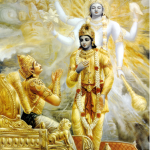Top 10 Modern Applications of the Bhagavad Gita’s Teachings – In today’s challenging world, unsettling events can serve as reminders of the darkness and dangers around us. Nevertheless, the Bhagavad Gita urges us to embrace our responsibilities earnestly, draw strength from spirituality, and approach life with a spirit of service. By embodying these principles, we actively contribute to creating a more compassionate and radiant corner of the world. By embracing a service attitude and recognizing our connection with the divine, we can play our part in bringing light to our corner of the world brighter instead of darker.
Bhagavad Gita informs us that we are tiny divine particles having the same quality as that of the Absolute divinity- Lord Krishna. Daily bathing in the message of the Bhagavad Gita will help us to revive our divinity- spiritual qualities.
Table of Contents
Top 10 Modern Applications of the Bhagavad Gita’s Teachings
Here are some Top 10 Modern Applications of the Bhagavad Gita’s Teachings of Bhagavad Gita Teachings-
1) Renunciation
कार्यमित्येव यत्कर्म नियतं क्रियतेऽर्जुन ।
सङ्गं त्यक्त्वा फलं चैव स त्याग: सात्त्विको मत: ॥ ९ ॥ (BG 18.9)
Perform your duties with this mindset: act without attachment to the results and remain detached from the methods of work. For instance, someone working in a factory with a focus on Krishna consciousness doesn’t identify themselves with the factory’s tasks or its workers. Their sole dedication lies in working for Krishna. When they relinquish the outcomes for Krishna’s sake, they operate on a transcendent level.
2) Leadership
सक्ताः कर्मण्यविद्वांसो यथा कुर्वन्ति भारत ।
कुर्याद्विद्वांस्तथासक्तश्चिकीर्षुर्लोकसङ्ग्रहम् ॥ २५ ॥ (BG 3.25)
The ignorant perform their duties with attachment to outcomes, whereas the learned carry out similar actions without attachment, aiming to guide others onto the right path. The distinction between a person in Krishna’s consciousness and one who isn’t lies in their desires. The Krishna-conscious individual refrains from actions that don’t foster Krishna consciousness. Even if their actions resemble those of someone attached to material pursuits, the difference lies in motivation: one acts for personal satisfaction, the other for Krishna’s pleasure. Hence, the Krishna-conscious person serves as an example, demonstrating how to act and channel the results of actions toward Krishna consciousness.
मात्रास्पर्शास्तु कौन्तेय शीतोष्णसुखदुःखदाः ।
आगमापायिनोऽनित्यास्तांस्तितिक्षस्व भारत ॥ १४ ॥ (BG 2.14)
Arjuna, embodying leadership, comprehended transient joy and sorrow akin to changing seasons, urging resilience amid life’s fluctuations. Just as individuals adhere to duties despite harsh climates – bathing in icy months or cooking in scorching heat – Arjuna upheld his warrior’s duty regardless of adversaries, even facing friends or kin. His leadership transcended personal dilemmas, rooted in adhering to righteous principles. Decisiveness defined him: timely, resolute choices guided by profound analysis. Arjuna epitomized leadership not just in decisive action, but in unwavering commitment to duty, recognizing that wisdom and devotion alone liberate from illusion’s grasp, embodying leadership’s essence in every decision.
3) Peace
भोक्तारं यज्ञतपसां सर्वलोकमहेश्वरम् ।
सुहृदं सर्वभूतानां ज्ञात्वा मां शान्तिमृच्छति ॥ २९ ॥ (BG 5.29)
Peace, according to the Bhagavad Gita, arises from acknowledging Lord Krishna as the ultimate benefactor in all actions. He is the proprietor of all realms and the well-wisher of every being. Understanding this truth and offering all endeavors to Krishna leads to peace from material suffering. The Gita illuminates that true tranquillity emerges from working with awareness of Krishna’s supremacy, beyond mental speculation. Kṛṣṇa consciousness isn’t just about duties; it’s about comprehending one’s relationship with the Supreme. By practicing Kṛṣṇa consciousness, one gradually transcends material influences, attaining spiritual existence while performing worldly duties. This leads to control over senses, conquering desires and anger, culminating in a state of transcendence—brahma-nirvāṇa—where peace reigns supreme.
4) Self-awareness
उद्धरेदात्मनात्मानं नात्मानमवसादयेत् ।
आत्मैव ह्यात्मनो बन्धुरात्मैव रिपुरात्मन: ॥ ५ ॥
बन्धुरात्मात्मनस्तस्य येनात्मैवात्मना जित: ।
अनात्मनस्तु शत्रुत्वे वर्तेतात्मैव शत्रुवत् ॥ ६ ॥
जितात्मन: प्रशान्तस्य परमात्मा समाहित: ।
शीतोष्णसुखदु:खेषु तथा मानापमानयो: ॥ ७ ॥
ज्ञानविज्ञानतृप्तात्मा कूटस्थो विजितेन्द्रिय: ।
युक्त इत्युच्यते योगी समलोष्ट्राश्मकाञ्चन: ॥ ८ ॥
सुहृन्मित्रार्युदासीनमध्यस्थद्वेष्यबन्धुषु ।
साधुष्वपि च पापेषु समबुद्धिर्विशिष्यते ॥ ९ ॥
योगी युञ्जीत सततमात्मानं रहसि स्थित: ।
एकाकी यतचित्तात्मा निराशीरपरिग्रह: ॥ १० ॥ (BG 6.5-10)
True self-awareness lies in mastering the mind, which can serve as both an ally and an adversary. Conquering the mind aligns one with the Supersoul, granting tranquility amidst life’s dualities. Achieving this state, happiness, distress, honor, and dishonor bear equal weight. A yogi attains self-realization, finding contentment through knowledge and transcending material distinctions. Further advancement comes in viewing everyone impartially—well-wishers, adversaries, friends, or foes. Engaging with the Supreme, a transcendentalist maintains seclusion, controlling desires, and possessiveness. This heightened self-awareness prompts an individual to perceive all—pebbles, stones, or gold—as equal. Thus, true mastery involves harmonizing body, mind, and self about the divine, fostering solitude, and attaining liberation from desires and attachments.
5) Modern psychology
यतो यतो निश्चलति मनश्चञ्चलमस्थिरम् ।
ततस्ततो नियम्यैतदात्मन्येव वशं नयेत् ॥ २६ ॥ (BG 6.26)
यया स्वप्नं भयं शोकं विषादं मदमेव च ।
न विमुञ्चति दुर्मेधा धृति: सा पार्थ तामसी ॥ ३५ ॥ (BG 18.35)
The mind’s erratic nature demands conscious redirection to the self. A realized yogi, a “gosvāmī,” doesn’t allow the mind to govern; instead, they master it, becoming the controllers rather than servants of their senses. This control brings the senses into service of a higher power, engaging in Krishna consciousness. This practice achieves supreme yoga, aligning with the owner of the senses, Krishna. Dreaming, inherent in all modes of mind, doesn’t cease in goodness but signifies excessive sleep. Those entrenched in material desires, fixated on dominance and material pleasures, exhibit determination rooted in ignorance. Modern psychology parallels this: self-mastery involves redirecting the wandering mind, understanding its influence, and exercising control. This process mirrors psychological practices emphasizing mindfulness, emphasizing the need to harness the mind’s tendencies for holistic well-being and clarity.
6) Modern Management
योगस्थः कुरु कर्माणि सङ्गं त्यक्त्वा धनञ्जय ।
सिद्ध्यसिद्ध्योः समो भूत्वा समत्वं योग उच्यते ॥ ४८ ॥ ( Bg 2.48)
बुद्धियुक्तो जहातीह उभे सुकृतदुष्कृते ।
तस्माद्योगाय युज्यस्व योगः कर्मसु कौशलम् ॥ ५० ॥ (Bg 2.50)
Krishna advises Arjuna on the essence of effective management: performing duties with equipoise, detached from success or failure—a principle crucial in modern management practices. He defines yoga as directing the mind to the Supreme, controlling turbulent senses. Krishna instructs Arjuna to fight not for personal gain but according to His guidance, highlighting a key managerial ethos—leadership by serving a higher purpose. Krishna consciousness—surrendering to Krishna’s will—transcends the sense of ownership, fostering service over self-interest, a core tenet in contemporary leadership models. It emphasizes delivering duties for a greater cause. Applying Bhagavad-gita’s teachings aligns with modern management’s emphasis on balanced action, transcending personal gain, and promoting selfless service in leadership, aiming for holistic success by integrating spiritual wisdom into management practices.
7) Tolerance and controlling anger
श्रीभगवानुवाच
अभयं सत्त्वसंशुद्धिर्ज्ञानयोगव्यवस्थिति: ।
दानं दमश्च यज्ञश्च स्वाध्यायस्तप आर्जवम् ॥ १ ॥
अहिंसा सत्यमक्रोधस्त्याग: शान्तिरपैशुनम् ।
दया भूतेष्वलोलुप्त्वं मार्दवं ह्रीरचापलम् ॥ २ ॥
तेज: क्षमा धृति: शौचमद्रोहो नातिमानिता ।
भवन्ति सम्पदं दैवीमभिजातस्य भारत ॥ ३ ॥ (BG 16.1-3)
In navigating modern society, imbibing qualities like fearlessness, purity, and spiritual knowledge promotes a harmonious existence. Anger, tolerance, and other virtues find relevance in contemporary life. Fearlessness, essential for a renounced life, reflects in relying on inner strength rather than external support.
Purifying oneself involves abstinence from harmful behaviors, especially regarding intimate relationships, echoing self-discipline in managing modern temptations. Tolerance signifies controlling impulsive reactions and navigating diverse viewpoints without hostility, crucial in a diverse, interconnected world.
Charity in modern terms extends beyond material donations, embracing the selfless sharing of knowledge, time, and compassion. Upholding truthfulness translates to authenticity and ethical conduct, essential in professional and personal spheres. Nonviolence extends beyond physical acts, advocating for respectful discourse and conflict resolution.
Cultivating these virtues requires inner discipline, aligning with modern mindfulness practices. Austerity symbolizes detachment from excessive material indulgence, promoting simplicity and mindful consumption in a consumerist culture. Modern life demands maintaining cleanliness, not only physically but also in communication and conduct, fostering respectful interactions.
Modern society can imbibe these transcendental qualities to foster a more tolerant, compassionate, and harmonious environment, enhancing personal growth and societal well-being.
8) Dealing with envy
तानहं द्विषत: क्रूरान्संसारेषु नराधमान् ।
क्षिपाम्यजस्रमशुभानासुरीष्वेव योनिषु ॥ १९ ॥ (Bg 16.19)
श्रद्धावाननसूयश्च शृणुयादपि यो नर: ।
सोऽपि मुक्त: शुभाँल्लोकान्प्राप्नुयात्पुण्यकर्मणाम् ॥ ७१ ॥ (BG 18.71)
The Bhagavad Gita speaks of how envy and malice lead individuals toward perpetual cycles of suffering. Those consumed by envy face a destiny determined not by their will but by divine arrangement. The above verse asserts that the demoniac, envious of divine authority, repeatedly inhabits demon-like existences due to their malicious nature. Conversely, those who listen with faith and without envy find freedom from sin, ascending to auspicious realms among the righteous.
The Gita’s wisdom highlights the significance of avoiding envy and fostering faith in divine principles. It delineates that even non-devotees, receptive to the teachings without malice, experience liberation from sin. This wisdom enables individuals to transcend envy’s shackles, guiding them toward righteousness and liberation from karmic cycles. Thus it emphasizes that embracing these teachings facilitates spiritual elevation, liberating one from envy’s entrapment and steering them toward spiritual righteousness and freedom.
9) Losing Hope
यदृच्छालाभसंतुष्टो द्वन्द्वातीतो विमत्सरः ।
समः सिद्धावसिद्धौ च कृत्वापि न निबध्यते ॥ २२ ॥ (BG 4.22)
सर्वधर्मान्परित्यज्य मामेकं शरणं व्रज ।
अहं त्वां सर्वपापेभ्यो मोक्षयिष्यामि मा शुच: ॥ ६६ ॥ (BG 18.66)
The Bhagavad Gita illuminates the path of surrendering to Krishna even amidst challenges. It emphasizes contentment with the fruits of labor and freedom from envy, advocating steadiness through success and failure. A Krishna-conscious person doesn’t strive intensely for sustenance but relies on honest labor, independent yet unwavering in serving Krishna.
Surrender to Krishna transcends all religious processes. Despite doubts about freeing oneself from sin, surrendering to Krishna brings automatic liberation. The Hari-bhakti-villa outlines surrender as aligning with Krishna’s will, fostering trust in His protection, and recognizing our helplessness without Him.
The essence of Gita lies in attraction to Krishna’s all-attractive nature. Devotional service to Krishna is the ultimate knowledge. Amid perplexities, the Gita consoles – “Don’t fear, surrender.” It assures that wholehearted surrender to Krishna transcends uncertainties and liberates from all sins, nurturing unwavering hope and faith.
10) Overcoming Depression
क्लैब्यं मा स्म गमः पार्थ नैतत्त्वय्युपपद्यते ।
क्षुद्रं हृदयदौर्बल्यं त्यक्त्वोत्तिष्ठ परन्तप ॥ ३ ॥ (BG 2.3)
मात्रास्पर्शास्तु कौन्तेय शीतोष्णसुखदुःखदाः ।
आगमापायिनोऽनित्यास्तांस्तितिक्षस्व भारत ॥ १४ ॥ (BG 2.14)
बाह्यस्पर्शेष्वसक्तात्मा विन्दत्यात्मनि यत्सुखम् ।
स ब्रह्मयोगयुक्तात्मा सुखमक्षयमश्नुते ॥ २१ ॥ (BG 5.21)
Arjuna’s struggle, captured in the Bhagavad Gita, resonates profoundly with modern challenges like depression. Despite his noble heritage and intimate connection with Krishna, Arjuna felt paralyzed by doubt and anguish, contemplating withdrawal from his duty in the face of an impending battle. Krishna’s counsel addressed Arjuna’s crisis of identity, highlighting that renouncing duty was a sign of weakness, not magnanimity.
Krishna’s teachings urge embracing discomfort and duty despite transient joy or sorrow, akin to enduring extremes of weather to fulfill obligations. The honor-bound duty of a warrior paralleled the modern commitment to responsibilities even amid personal conflicts. The Bhagavad Gita teaches resilience by emphasizing responsibility rooted in heritage. Arjuna’s lineage represented a legacy of duty, underscoring the responsibility inherited by modern civilizations through their cultural, ethical, and societal heritage. The Bhagavad Gita’s wisdom lies in navigating challenges, and transcending sensual pleasures for a higher purpose. Arjuna’s transformation signifies embracing duty over temporary emotional impulses. This ancient dialogue’s essence lies in understanding that fulfillment comes from duty, not fleeting pleasures. Arjuna’s triumph over despair underscores the path to overcoming modern afflictions like depression: embracing responsibility, duty, and a higher calling beyond momentary emotional gratification.
Conclusion:
Thus the Bhagavad Gita, with its timeless wisdom, resonates profoundly in modern life, offering invaluable lessons across diverse spheres. Renunciation, leadership, resilience, peace, self-awareness, modern psychology, management principles, virtues, and even the struggle with envy and despair find resonance in its teachings. These insights transcend time and culture, offering profound guidance in navigating contemporary challenges. Each teaching echoes a call for inner transformation and a higher perspective, urging individuals to act with detachment, embrace their responsibilities, and prioritize duty over momentary pleasures. The Gita’s essence lies in finding fulfillment through selfless action, transcending the fleeting allure of material desires.
Moreover, the Gita provides a roadmap for tackling depression by emphasizing resilience, commitment to duty, and a higher purpose. Arjuna’s triumph over despair symbolizes the journey to overcome modern afflictions by embracing responsibility and a higher calling.
In essence, the Bhagavad Gita serves as a beacon of wisdom, guiding individuals to navigate life’s complexities, discover inner strength, and ultimately find fulfillment by aligning actions with duty and embracing a higher purpose beyond transient emotions and material desires.




